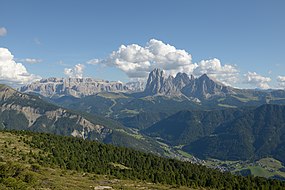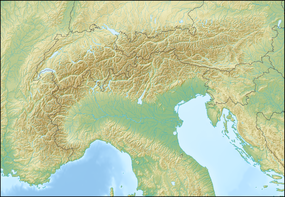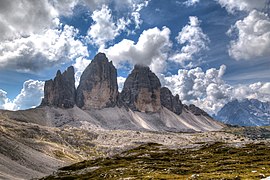Dolomites
| Dolomites | |
|---|---|
Italian: Dolomiti German: Dolomiten | |
 View on the Western Dolomites in Gherdëina | |
| Highest point | |
| Peak | Marmolada |
| Elevation | 3,343 m (10,968 ft) |
| Coordinates | 46°26′N 11°51′E / 46.433°N 11.850°E / 46.433; 11.850Coordinates: 46°26′N 11°51′E / 46.433°N 11.850°E / 46.433; 11.850 |
| Geography | |
 Dolomites Location of the Dolomites in the Alps | |
| Country | Italy |
| Province | Belluno, South Tyrol and Trentino |
| Parent range | Alps |
| Geology | |
| Orogeny | Alpine orogeny |
| Age of rock | Mostly Triassic |
| Type of rock | Sedimentary rocks, including dolomite, and volcanics |
 The Three Peaks of Lavaredo | |
| UNESCO World Heritage Site | |
| Criteria | Natural: vii, viii |
| Reference | 1237 |
| Inscription | 2009 (33rd Session) |
| Area | 141,902.8 ha |
| Buffer zone | 89,266.7 ha |
The Dolomites (Italian: Dolomiti [doloˈmiːti]; Ladin: Dolomites; German: Dolomiten [doːloːˈmɪtn̩] (![]() listen); Venetian: Dołomiti [doɰoˈmiti]: Friulian: Dolomitis) are a mountain range located in northeastern Italy. They form a part of the Southern Limestone Alps and extend from the River Adige in the west to the Piave Valley (Pieve di Cadore) in the east. The northern and southern borders are defined by the Puster Valley and the Sugana Valley (Italian: Valsugana). The Dolomites are nearly equally shared between the provinces of Belluno, South Tyrol and Trentino.
listen); Venetian: Dołomiti [doɰoˈmiti]: Friulian: Dolomitis) are a mountain range located in northeastern Italy. They form a part of the Southern Limestone Alps and extend from the River Adige in the west to the Piave Valley (Pieve di Cadore) in the east. The northern and southern borders are defined by the Puster Valley and the Sugana Valley (Italian: Valsugana). The Dolomites are nearly equally shared between the provinces of Belluno, South Tyrol and Trentino.
Other mountain groups of similar geological structure spread along the River Piave to the east – Dolomiti d'Oltrepiave; and far away over the Adige River to the west – Dolomiti di Brenta (Western Dolomites). A smaller group is called Piccole Dolomiti (Little Dolomites), located between the provinces of Trentino, Verona, and Vicenza (see map).
The Dolomiti Bellunesi National Park and many other regional parks are located in the Dolomites. In August 2009, the Dolomites were declared a UNESCO World Heritage Site.
Contents
1 Etymology
2 History
3 Geography
3.1 Current classification
4 Tourism
5 Major peaks
6 Major passes
7 Major parks
8 Panoramic view
9 See also
10 References
11 Bibliography
12 External links
Etymology
The Dolomites, also known as the "Pale Mountains", take their name from the carbonate rock dolomite. This was named for 18th-century French mineralogist Déodat Gratet de Dolomieu (1750–1801), who was the first to describe the mineral.[1]
History
The Dolomites were formed during the Permian period over 280 million years ago, when parts of Europe and Africa were merged in a supercontinent known as Pangaea. During that time, there was a tropical sea and a great oceanic gulf called the Tethys. The mountains were thrust up and have since weathered.
During the First World War, the front line between the Italian and Austro-Hungarian forces ran through the Dolomites, where both sides used mines extensively. Open-air war museums are located at Cinque Torri (Five Towers) and Mount Lagazuoi. Many people visit the Dolomites to climb the vie ferrate, protected paths through the minefields that created during the war.
A number of long-distance footpaths traverse the Dolomites. They are called alte vie (high paths), and are numbered from 1 to 8. The trails take on the order of a week to walk, and are served by numerous rifugi (huts). The first and perhaps most renowned is the Alta Via 1.
Radiocarbon dating has been used in the Alta Badia region to demonstrate a connection between landslide activity and climate change.[2]
Geography
The region is commonly divided into the Western and Eastern Dolomites, separated by a line following the Val Badia – Campolongo Pass – Cordevole Valley (Agordino) axis.
Current classification
The Dolomites may be divided into the following ranges:
|
|
|
Tourism

Girl on a swing in the Dolomites

The very beautiful Dolomites 2018 [3]
The Dolomites are renowned for skiing in the winter months and mountain climbing, hiking, cycling, and BASE jumping, as well as paragliding and hang gliding in summer and late spring/early autumn.[citation needed]Free climbing has been a tradition in the Dolomites since 1887, when 17-year-old Georg Winkler soloed the first ascent of the pinnacle Die Vajolettürme.[4] The main centres include: Rocca Pietore alongside the Marmolada Glacier, which lies on the border of Trentino and Veneto, the small towns of Alleghe, Falcade, Auronzo, Cortina d'Ampezzo and the villages of Arabba, Urtijëi and San Martino di Castrozza, as well as the whole of the Fassa, Gardena and Badia valleys.
The Maratona dles Dolomites, an annual single-day road bicycle racing race covering seven mountain passes of the Dolomites, occurs in the first week of July.
Other characteristic places are:
- Mount Pasubio and Strada delle 52 Gallerie (a military mule road built during World War I with 52 tunnels)
Altopiano di Asiago and Calà del Sasso, with 4444 steps, the world's longest staircase open to the public.
Major peaks

Tofana Group

Winter view of the Sella Group

Vajolettürme

Gran Cir
| Name | metres | feet | Name | metres | feet |
|---|---|---|---|---|---|
Marmolada | 3,343 | 10,968 | Pala di San Martino | 2,982 | 9,831 |
Antelao | 3,264 | 10,706 | Rosengartenspitze / Catinaccio | 2,981 | 9,781 |
Tofana di Mezzo | 3,241 | 10,633 | Cima di Fradusta | 2,941 | 9,715 |
Sorapiss | 3,229 | 10,594 | Cimon del Froppa | 2,932 | 9,649 |
Cristallo | 3,221 | 10,568 | Monte Agnèr | 2,872 | 9,416 |
Monte Civetta | 3,220 | 10,564 | Fermedaturm | 2,867 | 9,407 |
Cima di Vezzana | 3,192 | 10,470 | Cima d'Asta | 2,848 | 9,344 |
Cimon della Pala | 3,184 | 10,453 | Cima di Canali | 2,846 | 9,338 |
Langkofel / Sassolungo | 3,181 | 10,427 | Croda Grande | 2,839 | 9,315 |
Monte Pelmo | 3,168 | 10,397 | Vajoletturm / Torri del Vajolet (highest) | 2,821 | 9,256 |
Dreischusterspitze | 3,162 | 10,375 | Sass Maor | 2,816 | 9,239 |
Boespitze / Piz Boè (Sella group) | 3,152 | 10,342 | Cima di Ball | 2,783 | 9,131 |
Hohe Gaisl (Croda Rossa d'Ampezzo) | 3,148 | 10,329 | Cima della Madonna (Sass Maor) | 2,751 | 9,026 |
Vernel | 3,145 | 10,319 | Rosetta | 2,741 | 8,993 |
Piz Popena | 3,143 | 10,312 | Croda da Lago | 2,716 | 8,911 |
Grohmannspitze (Langkofel) | 3,126 | 10,256 | Central Grasleitenspitze | 2,705 | 8,875 |
Zwölferkofel | 3,094 | 10,151 | Schlern | 2,562 | 8,406 |
Elferkofel | 3,092 | 10,144 | Sasso di Mur | 2,554 | 8,380 |
Sass Rigais (Geislerspitzen) | 3,025 | 9,925 | Cima delle Dodici | 2,338 | 7,671 |
Kesselkogel (Rosengarten) | 3,004 | 9,856 | Monte Pavione | 2,336 | 7,664 |
Tre Cime di Lavaredo (Drei Zinnen) | 2,999 | 9,839 | Cima Palon | 2,239 | 7,346 |
| Fünffingerspitze | 2,997 | 9,833 | Cima di Posta | 2,235 | 7,333 |
Major passes

Langkofel/Sassolungo

Pordoi Pass

Falzarego Pass

Gardena Pass
| Name | metres | feet |
|---|---|---|
| Ombretta Pass (Campitello to Caprile), footpath | 2,738 | 8,983 |
| Langkofeljoch (Gröden Valley to Campitello), footpath | 2,683 | 8,803 |
| Tschagerjoch (Karersee to the Vajolet Glen), footpath | 2,644 | 8,675 |
| Grasleiten Pass (Vajolet Glen to the Grasleiten Glen), footpath | 2,597 | 8,521 |
| Pravitale Pass (Rosetta Plateau to the Pravitale Glen), footpath | 2,580 | 8,465 |
| Comelle Pass (same to Cencenighe), footpath | 2,579 | 8,462 |
| Rosetta Pass (San Martino di Castrozza to the great limestone Rosetta plateau), footpath | 2,573 | 8,442 |
| Vajolet Pass (Tiers to the Vajolet Glen), footpath | 2,549 | 8,363 |
| Canali Pass (Primiero to Agordo), footpath | 2,497 | 8,193 |
| Tierseralpljoch (Campitello to Tiers), footpath | 2,455 | 8,055 |
| Ball Pass (San Martino di Castrozza to the Pravitale Glen), footpath | 2,450 | 8,038 |
| Forcella di Giralba (Sexten to Auronzo), footpath | 2,436 | 7,992 |
| Col dei Bos (Falzarego Glen to the Travernanzes Glen), footpath | 2,313 | 7,589 |
| Forcella Grande (San Vito to Auronzo), footpath | 2,262 | 7,422 |
Pordoi Pass (Arabba to Val di Fassa), road | 2,250 | 7,382 |
Sella Pass (Gröden Valley to Val di Fassa), road | 2,244 | 7,362 |
Giau Pass (Cortina to Val Fiorentina), road | 2,236 | 7,336 |
| Tre Sassi Pass (Cortina to St Cassian), footpath | 2,199 | 7,215 |
Valparola Pass (Cortina to St Cassian), road | 2,168 | 7,113 |
| Mahlknechtjoch (Upper Duron Glen to the Seiser Alp), footpath | 2,168 | 7,113 |
Gardena Pass (Gröden Valley to Colfuschg), road | 2,121 | 6,959 |
Falzarego Pass (Caprile to Cortina), road | 2,117 | 6,946 |
| Fedaja Pass (Val di Fassa to Caprile), bridle path | 2,046 | 6,713 |
| Valles Pass (Paneveggio to Falcade), road | 2,032 | 6,667 |
Würzjoch (Eisacktal to Val Badia), road | 2,003 | 6,572 |
Rolle Pass (Predazzo to San Martino di Castrozza and Primiero), road | 1,984 | 6,509 |
| Forcella Forada (Caprile to San Vito), bridle path | 1,975 | 6,480 |
San Pellegrino Pass (Moena to Cencenighe), road | 1,910 | 6,267 |
Campolongo Pass (Corvara to Arabba), road | 1,875 | 6,152 |
| Forcella d'Alleghe (Alleghe to the Zoldo Glen), footpath | 1,820 | 5,971 |
| Tre Croci Pass (Cortina to Auronzo), road | 1,808 | 5,932 |
| Furkel Pass (Mareo to Olang), road | 1,759 | 5,771 |
Karerpass or Costalunga Pass (Welschnofen to Vigo di Fassa), road | 1,753 | 5,751 |
Kreuzbergpass or Monte Croce Pass (Innichen and Sexten to the Piave Valley and Belluno), road | 1,638 | 5,374 |
| Ampezzo Pass (Toblach to Cortina and Belluno), path | 1,544 | 5,066 |
Cereda Pass (Primiero to Agordo), road | 1,372 | 4,501 |
| Toblach Pass (Bruneck to Lienz), railway | 1,209 | 3,967 |
Major parks
|
|
|
Panoramic view

360° panoramic view from Marmolada, highest peak in the Dolomites

Panoramic view of Lavaredo
See also
- Alta Via 1
- Belluno
- Dolomiti Bellunesi National Park
- Strada delle 52 Gallerie
- Via Ferrata
- White Friday (1916)
References
^ Saussure le fils, M. de (1792): "Analyse de la dolomite". Journal de Physique, vol. 40, pp. 161–173.
^ Borgatti, Lisa; Soldati, Mauro (2010-08-01). "Landslides as a geomorphological proxy for climate change: A record from the Dolomites (northern Italy)". Geomorphology. Landslide geomorphology in a changing environment. 120 (1–2): 56–64. doi:10.1016/j.geomorph.2009.09.015..mw-parser-output cite.citation{font-style:inherit}.mw-parser-output .citation q{quotes:"""""""'""'"}.mw-parser-output .citation .cs1-lock-free a{background:url("//upload.wikimedia.org/wikipedia/commons/thumb/6/65/Lock-green.svg/9px-Lock-green.svg.png")no-repeat;background-position:right .1em center}.mw-parser-output .citation .cs1-lock-limited a,.mw-parser-output .citation .cs1-lock-registration a{background:url("//upload.wikimedia.org/wikipedia/commons/thumb/d/d6/Lock-gray-alt-2.svg/9px-Lock-gray-alt-2.svg.png")no-repeat;background-position:right .1em center}.mw-parser-output .citation .cs1-lock-subscription a{background:url("//upload.wikimedia.org/wikipedia/commons/thumb/a/aa/Lock-red-alt-2.svg/9px-Lock-red-alt-2.svg.png")no-repeat;background-position:right .1em center}.mw-parser-output .cs1-subscription,.mw-parser-output .cs1-registration{color:#555}.mw-parser-output .cs1-subscription span,.mw-parser-output .cs1-registration span{border-bottom:1px dotted;cursor:help}.mw-parser-output .cs1-ws-icon a{background:url("//upload.wikimedia.org/wikipedia/commons/thumb/4/4c/Wikisource-logo.svg/12px-Wikisource-logo.svg.png")no-repeat;background-position:right .1em center}.mw-parser-output code.cs1-code{color:inherit;background:inherit;border:inherit;padding:inherit}.mw-parser-output .cs1-hidden-error{display:none;font-size:100%}.mw-parser-output .cs1-visible-error{font-size:100%}.mw-parser-output .cs1-maint{display:none;color:#33aa33;margin-left:0.3em}.mw-parser-output .cs1-subscription,.mw-parser-output .cs1-registration,.mw-parser-output .cs1-format{font-size:95%}.mw-parser-output .cs1-kern-left,.mw-parser-output .cs1-kern-wl-left{padding-left:0.2em}.mw-parser-output .cs1-kern-right,.mw-parser-output .cs1-kern-wl-right{padding-right:0.2em}
^ Millett, David. "The very beautiful Dolomites 2018".
^ Huber, Alex. "The Perfect Perfume". Rock and Ice Magazine. Archived from the original on 2008-02-15.
Bibliography
 This article incorporates text from a publication now in the public domain: Chisholm, Hugh, ed. (1911). . Encyclopædia Britannica. 8 (11th ed.). Cambridge University Press. p. 394.
This article incorporates text from a publication now in the public domain: Chisholm, Hugh, ed. (1911). . Encyclopædia Britannica. 8 (11th ed.). Cambridge University Press. p. 394.
- Provincia di Belluno, Provincia Autonoma di Bolzano-Alto Adige Autonome Provinz Bozen-Südtirol, Provincia di Pordenone, Provincia Autonoma di Trento, Provincia di Udine, Regione Autonoma Friuli Venezia Giulia, 2008. Nomination of the Dolomites for inscription on the World Natural Heritage List UNESCO. Nomination Document. 363 pp. https://web.archive.org/web/20131225070444/http://fondazionedolomitiunesco.org/documentazione-2/01_DOLOMITES_nomination_document_jan2008_1236608233_1294933181.pdf
"HD Pictures of the main areas of the Dolomites". Bruno Mandolesi.
"360 degree panorama Dolomites". SiMedia Srl. Retrieved 14 April 2010.
Roger. "Walks and Via Ferrata in the Dolomites". CommunityWalk.com. Retrieved 14 April 2010.
"Strada delle 52 Gallerie". Eclectica.
"Monte Piana in the Dolomites". Eclectica. August 21, 2006.
"Via Ferrata Lagazuoi Tunnels". Eclectica. August 9, 2006.
"Up to the Turquoise Lake". Eclectica. August 1, 2006.
External links
![]() Media related to Dolomites at Wikimedia Commons
Media related to Dolomites at Wikimedia Commons
- Franco Grisa Timelapse
- Italian official cartography (Istituto Geografico Militare - IGM); on-line version: www.pcn.minambiente.it

